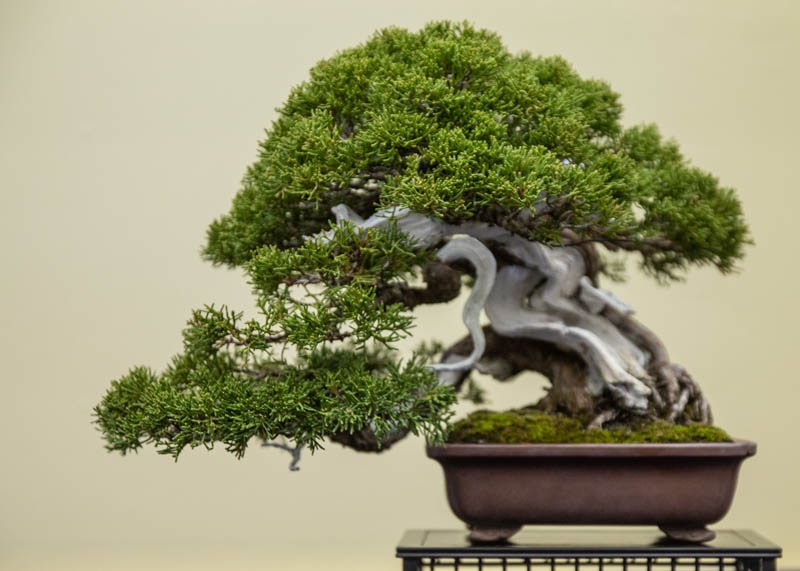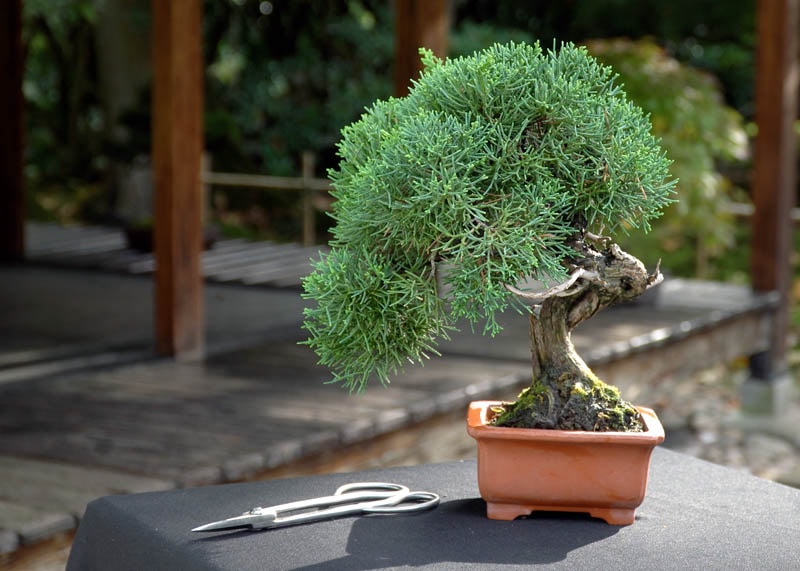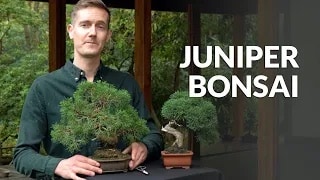Juniper Bonsai Care guidelines
Place the tree outside, year-round, in a bright location with lots of sunlight. The Juniper cannot live indoors. During the winter protect the tree once temperatures drop below 15 °F (-10 °C), for example by placing it in a coldframe. Some species change their foliage color during frosty periods to a purplish brown which is a part of their internal frost protection mechanism. Don’t worry they will turn green again in spring.
Be careful not to overwater, as the juniper’s roots don't like soil wetness. Before you water, the soil should slightly dry. Misting the tree can be done regularly, especially after the tree has been repotted because it benefits from air humidity. Continue reading about watering Bonsai trees.
Watering
Free lecture from the Beginners CourseUse normal organic fertilizer pellets every month during the growing season or a liquid fertilizer every week. If you’d like to see strong growth you can apply some higher nitrogen levels in the spring.
To develop the foliage pads, long shoots that stick out of the silhouette can be pinched or cut at the base with sharp scissors throughout the growing season. Do not trim the juniper like a hedge because the removal of all growing tips will weaken the tree and the cut will turn the needles brown. When the foliage pads become too dense they must be thinned out with sharp scissors at the base. The Juniper Bonsai is generally a strong tree that also withstands aggressive pruning very well. But it cannot bud again from bare tree parts, so take care that there is some foliage left on every branch you wish to keep alive. Continue reading about pruning Bonsai trees.
Junipers produced for Bonsai are often heavily wired when they are very young. Dramatically twisted shapes are very popular and correspond with the natural shapes that used to grow in the Japanese mountains. Junipers can be bent aggressively, but be sure to wrap branches with raffia or tape for protection. Use caution when bending areas with deadwood as those parts do break easily. If they are large and old, you can split the deadwood to bend the more flexible living parts. The foliage pads should be wired and fanned out after thinning, to let light and air get in, otherwise, the inner parts of the foliage pads will die, and dense pads also increase the risk of pest infestation. Aesthetically, we want unobstructed structures to avoid the juniper from looking like broccoli.
Repot the Juniper Bonsai tree once every two years using a basic, or slightly more draining soil mixture. Very old trees can be repotted at longer intervals. Do not prune the roots too aggressively. The best moment to repot is the early spring. Continue reading about repotting Bonsai trees.
Use seeds or cuttings for propagation. Many well-suited juniper species in different sizes can be found in most nurseries. You can usually find good raw material for Bonsai there. Old junipers can be found in gardens, concrete pots, and on cemeteries, with old graves that will be cleared, and if you are lucky the owner will allow you to dig one out for little money or a new plant. Specialized Bonsai traders offer everything from young plants, pre-Bonsai, and pre-styled juniper trees up to high-value Bonsai in various styles and shapes.
If junipers are well cared for and placed in an ideal location they are very resistant to pests. Make sure not to allow foliage pads to get too dense otherwise, pests can settle in them more easily. During winter the junipers must be kept in a place with enough light and they must be checked for pests regularly even in winter. Junipers can sometimes get infested with spider mites, juniper scale, juniper aphids, and juniper needle miners as well as juniper webworms. Traditional insecticide/miticide sprays will help but if you want to get rid of pests, you should investigate why the tree was prone to infestation. Fungal rust diseases are a big problem. Juniper species have different levels of susceptibility to rust fungus. Some are even considered resistant to fungal rust diseases. As a rule of thumb, the blue-green junipers are more resistant than those with yellowish-green foliage. The Japanese junipers are also not infested often. You can find files that list many juniper species and cultivars and their susceptibility/resistance level to rust fungus on the internet. The rust fungus infests the junipers permanently and cannot be cured. It causes swellings that erupt with brown galls. During winter, particularly in rainy weather, the galls produce large, orange, gelatin-like tendrils, full of spores that infest the leaves of pear trees or hawthorn/crabapples. You can identify the fungus when you see orange spots on the pear leaves. In late summer brownish proliferations grow from the bottom-sides of the leaves which release spores that infest junipers. While the pear trees in most cases are not fatally affected – they are newly infected each year, and they can even be treated successfully with a fungicide. An infected juniper normally cannot be cured. The visibly infested branches die in most cases and the fungus can emerge on other tree parts. Removing the parts with the swellings and galls is no guarantee that the fungus will not reappear. Some people have a different opinion, but it’s best to burn rust-infested juniper immediately or put it into the garbage instead of your compost heap. For more detailed information on these techniques, check out our Bonsai tree care section.

Juniper bonsai tree

Foliage of the Juniper

Needle juniper bonsai

Rocky Mountain Juniper

Chinese juniper (Juniperus chinensis)
General information about the Juniper Bonsai tree
The Juniper Bonsai trees that can be found in large stores, like Walmart and Home Depot, are often Japanese Garden Junipers, also known as Green Mound Junipers (Juniperus procumbens nana.) Other popular species include the Chinese juniper (Juniperus Chinensis,) the Japanese Shimpaku (Juniperus sargentii,) the Japanese needle juniper (Juniperus rigida), two central European species: The savin (Juniperus sabina,) and the common juniper (Juniperus communis.) It also includes three American species: The California Juniper (Juniperus californica,) the Rocky Mountain Juniper (Juniperus scopulorum,) and the Sierra Juniper (Juniperus occidentalis). All of which have very similar care guidelines. If you need help identifying your tree, take a look at our Bonsai tree identification guide.
Scale junipers’ new growth, or juvenile foliage, appears needle-like until the typical scale-like foliage appears when they mature. Juvenile growth can also result from heavy pruning, bending, or overwatering and can last as long as a few years until the normal scale-like foliage grows and the young needle-like foliage falls or can be removed. The foliage color can range from steely-blue-greens to light greens, occasionally with silver or gold hues.
The berry-like cones are round or oval and are filled with round or edged seeds. Depending on the species they can measure from 1/8" to 1" (0,3 - 2cm), and it usually takes a year or two to ripen. The cones are often eaten by birds who spread the germinable seeds through the bird’s droppings.
Junipers are also great for jin and shari, or deadwood. It grows live veins below broken or dying branches that dry out and die to make deadwood. The deadwood is then naturally peeled, polished, and bleached by climatic conditions that make it very durable. The triad of green foliage, reddish-brown or yellowish-brown bark, and silvery-white deadwood is very appealing. For photos of a few spectacular Junipers, check the Juniper Bonsai top 10.
Identify your Juniper species
There are two groups of Junipers, one with scale-like foliage and the other one with needle-like foliage.
The two most popular juniper species for bonsai with scale-like foliage are the Chinese Juniper and the Japanese Shimpaku. The Japanese Shimpaku is actually a variety of Chinese Juniper which was originally found in the mountains of Japan. Both have scale-like foliage with color ranging from yellowish-green to bluish-green or silver-green. Another very popular juniper for bonsai is the Itoigawa Shimpaku due to its delicate emerald-green foliage. There are numerous varieties of Chinese Juniper, many of which difficult to distinguish with certainty, but the care guidelines for these varieties are very similar. Check this article for the styling of a Juniper. The Savin is a juniper from southern Europe, North-Africa, and some parts of Asia with scale-like foliage which can be finer or more coarse and has different shades of green depending on its origin. All parts of the Savin are poisonous. The California Juniper is native to California and has bluish-grey scale-like foliage. In nature, it grows as a small tree or shrub. The Rocky Mountain Juniper grows in western North-America and can become a tall tree. Its leaves are scale-like, coarse, and can be dark green or bluish-green. The Sierra Juniper is a shrub or tree native to the western United States. It grows in mountainous terrain at altitudes of 2500 to 10000 ft. (800–3000 meters) Its foliage is scale-like with grayish or dark green coloring and tends to grow quite dense.
There are also popular juniper species with needle-like foliage. The Japanese Needle Juniper has sharp, dark green, stinging needles with a narrow white line along their length. The Green Mound Juniper Bonsai is also from Japan with needle-like foliage, but the needles are shorter, more compact, and the coloring us bluish-green, similar to some scale-like foliage. This plant grows as a ground covering shrub if it is not shaped. The Common Juniper is native to Europe, North-America, Asia, and North-Africa. Its needles are sharp but smaller and more delicate than those of the Japanese Needle Juniper. In nature, it grows columnar or as a depressed shrub. Continue reading about the Needle juniper bonsai (Juniperus rigida).





